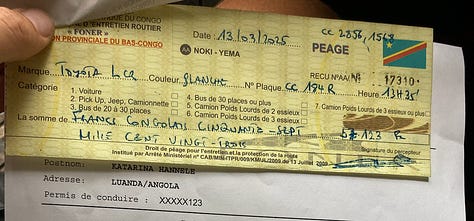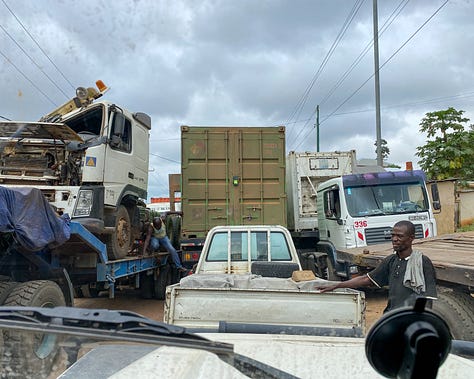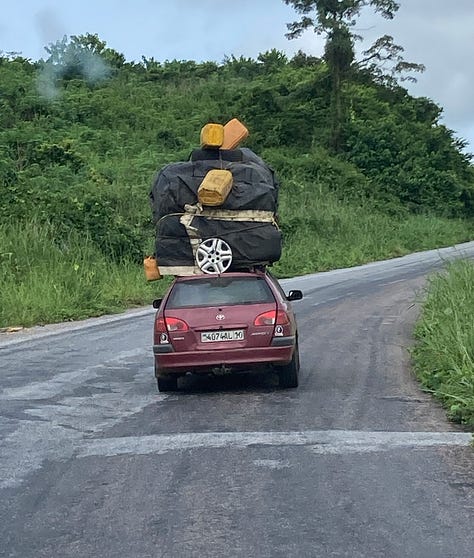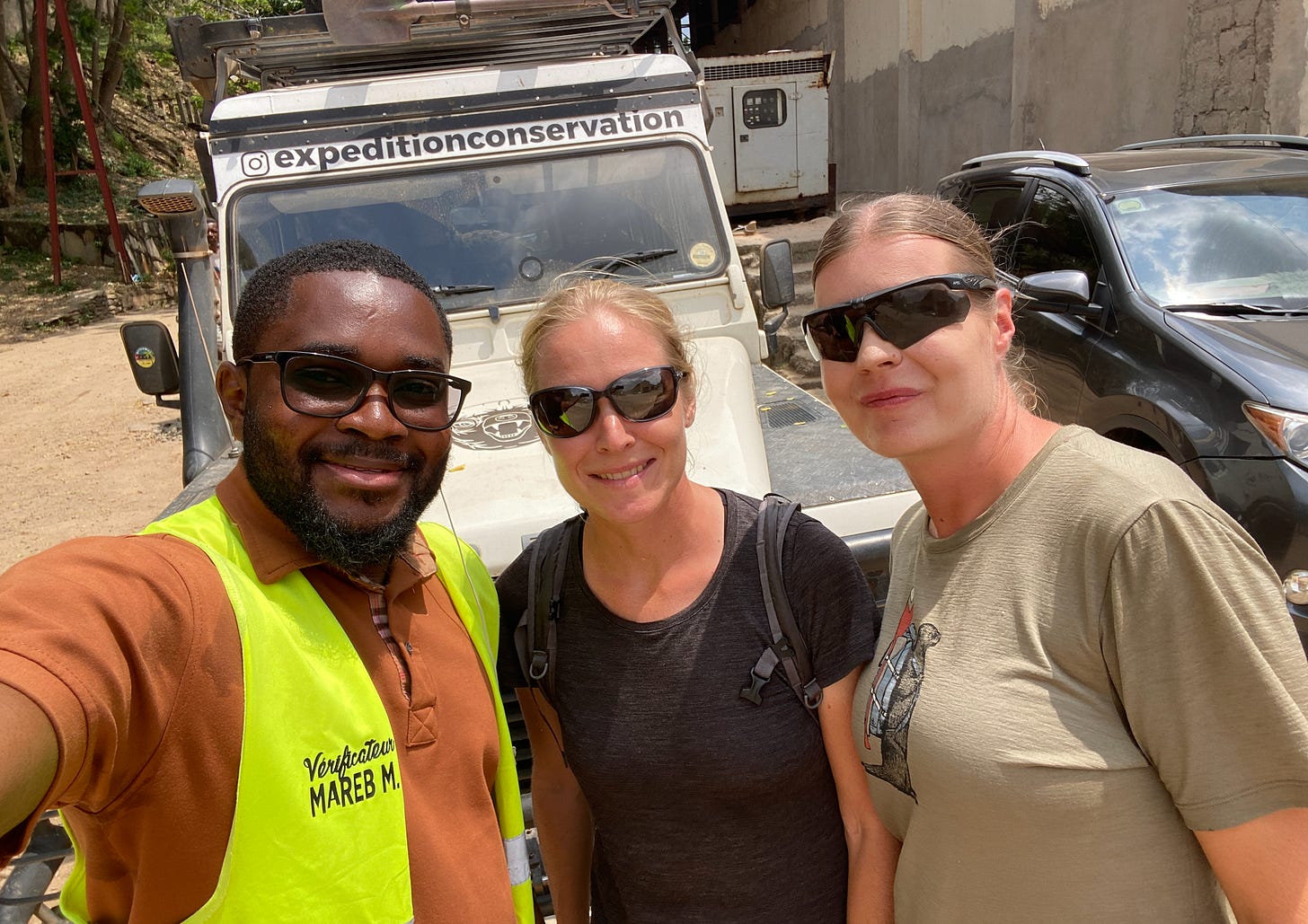How the Democratic Republic of the Congo (DRC) Was a Pleasant Surprise – And a Bonus Video!
After crossing Angola rather quickly, we had a country ahead that raises many tensions in people's mind – the DRC. Also, the recent M23 querilla uprisings in its eastern parts caused some thoughts.
When we arrived in Luanda, Angola, we drove straight to some local Land Rover mechanics, but immediately felt uncomfortable with them. Not least because of the lack of a mutual language, we thought that we didn’t want them to touch the car. If you can’t explain the problem, things are just too complicated and risky. We would have also wanted them to check the gearbox breather, but we failed.
We then went to a good Land Rover spare part shop, only to be met with a “no stock” message for a new TRW master cylinder. A parts shipment was coming, but it would take at least a week. So, we had another decision to make: to wait for a week (or more?), continue our journey and try to source the master cylinder from somewhere else, or order it from the UK with DHL (and wait for it).
We had to think about it, so we headed to the Yacht Club (Club Naval de Luanda), a place popular with overlanders for staying the night because it was free.
The Club Naval was a small concrete parking lot with a small grass area to sit on, a sink and water tap, a view of the city skyline, and many boats. It was pretty picturesque, actually. We just didn’t feel very relaxed, I guess we were just so tired and needed to rest.
But staying at the Club Naval was still free, and we didn’t mind sharing the small space with one big truck and another 4x4 for the first few nights. Sometimes, it’s also nice to exchange experiences and information with other travelers, even though all these people we met were doing this West African crossing the other way, from north to south. We took a few days to think about our different choices.
We also decided to skip Gabon, because the general elections were coming on April 12th. Because of that, it was difficult to get a visa issued ‘cause they didn’t want tourists to go to Gabon. Also, the other travelers said that it was very challenging to get through the border of Gabon and Cameroon, as the border was officially closed. All this information came on the “11th hour”, as we were supposed to go to the Gabonese embassy the next day to apply for visas.
After consideration, we didn’t want to take any “extra chances” or unnecessary difficulties and decided to cross directly to Cameroon from Congo Brazzaville. It vexed us a bit, as we would’ve wanted to visit Gabon, but all the extra hassle and the possibility of some unrest because of the general elections didn’t feel worth it. By skipping it, we would also save some time, as we are a bit short on time to reach Finland by the end of June at the latest.
And in hindsight, we have no regrets about missing Gabon–on the contrary. Because of this decision, we could now visit the fantastic Odzala-Kokoua National Park, at the heart of the Congo Basin, and its western lowland gorillas in the northern Republic of Congo, which otherwise would have been too far off the route!
If you have to give up on something, you often get something even better instead! 😊
From Luanda to the Noqui-Ango Ango Border of Matadi, the DRC
So we left towards the DRC with a master cylinder that leaked a bit. There was still an occasional drop in the pedal compartment, but the clutch fluid’s level had not dropped in the reservoir. The clutch worked fine; therefore, we dared to leave and drive through the DRC with it because it was not a long way.
We also heard that it might be possible to ship a new master from Luanda to Cabinda if the owner of the spare part shop had received his shipment by then.
We also know that it probably wasn’t the “smartest” decision, as we know what can happen to the slave, too, if the master fails… But we made a conscious decision. And luckily, nothing happened. I guess we wouldn’t do that again, though.
We drove this journey from Luanda towards the Matadi border in a few days, and stayed two nights wild camping on the way. On the day we crossed the border from Angola to the Democratic Republic of the Congo (DRC), we wanted to be there as early as possible. It was the DRC, after all, and we knew that the border crossing could take a lot of time.
In the end, it did take a lot of time, but not for the reason we initially thought. Stamping out of Angola was straightforward at the border, as was stamping our passports into the DRC. A friendly DGM (DRC immigration) officer took us to all the necessary places, and we didn’t even need to pay for the required photocopies.
But then came the problem of getting the temporary import permit for HB the Defender, as we do not have the Carnet de Passage (CDP).
The officers immediately knew about stamping the CDP, but first played ignorant about the Carte d’Entree, as the TIP is called in the DRC. We kept insisting in a friendly way, and after some time, one officer showed us the right kind of paper and then began all the running between offices and different people to get one. Fortunately, we had another friendly, English-speaking DGM guy with us to help. He was priceless, really.
While sorting out the TIP, we paid the US$25 road tax in another office.
After a long time, we eventually ended up at the port (!) office, where one port chief and his employees finally came up with the correct documents. We also needed a “Foner” (some customs permit) attached to the Carte d’Entree. However, at this point, it was afternoon, we had already lost about three hours, and we started getting pretty tired. Eating only a light breakfast, some nuts, and an energy bar only gets you so far…
We had read that everyone must pay US$15 for this document, even though it is officially free. We played the “ignorant tourist” card a bit when they asked for money and politely said we heard it should be free. After some time, the friendly officers actually gave it to us for free! In the DRC, you can consider that a win.



We were finally free to go. Except that when we got to the port gate, one grumpy officer decided to try to give us some trouble and wanted to “inspect” the car…
We showed him some stuff (pots, pans, clothes, etc.), but he wasn’t satisfied. Then Niina left with the guy somewhere, and I waited in the car. After a while, the same DGM guy who had helped us with the Carte d’Entree showed up and was surprised to see us still there. He shouted to the gate employees and vanished in Niina's direction.
I waited some more, and in about 20 minutes, Niina and all the guys returned with one new man. He quickly introduced himself as the port's managing director, apologized for his employees' bad behavior, gave his phone number “in case we face any trouble,” and wished us a safe journey. All in all, the only unfriendly guy at the whole border crossing was this one grumpy gate guy. Everybody else was very friendly and helpful.
So finally, after about 4+ hours at the border, we were free to drive into the DRC! 🇨🇩
What we paid at the border:
US$25 for road tax. We got an official, stamped receipt (see picture). You will need to show this at road tax checkpoints, and they take the yellow copy of it at the border where you exit the DRC.
Carte d’Entree & Fonér: for us, it was free (!). But you may need to pay US$15 for it at other borders.
If you have a CDP (Carnét de Passage) for your car, the officers will probably just stamp it in 5 minutes. They may ask you for money, but refusing politely will do the job.
The Worst Traffic Jam We’ve Ever Faced!
We started driving towards the Matadi bridge on the only road through the city, but about 1 km later, we were stopped by a traffic jam from hell.
And that was honestly the worst traffic jam we have ever faced!
The road from the Ango-Ango border to the Matadi bridge crossing the Congo River is only 6 kilometers but it took us 4 hours – can you imagine?! 🤯
I can assure you that you can’t imagine it. Below are a few images and a short phone video we took while standing in the endless queue and squeezing through the trucks. The spaces we had to squeeze through were also so small that we sometimes had only a few centimetres of space on both sides of HB the Defender. It was also pretty scary at times.



However, all the way, the people were smiling, waving, and greeting us friendly. They were seemingly happy to see tourists.
But as the clock started getting closer to 6 p.m. and sunset, we began to get stressed out. We wouldn’t have wanted to drive in the dark in the DRC, but that seemed to be inevitable now…
A few guys helped us move forward in the nightmare queue at the last stretch to finally drive through it. Without them, I don’t know how long we would have been stuck there…
It was already dark when we reached the Matadi bridge and crossed the Congo River. Still, somehow, this felt like a remarkable moment.
We had always wanted to see the legendary Congo River, and here it was, right before our eyes. We got to experience it by driving over it in our own car. It felt great.
The bridge toll was US$5 (with receipt). We also had to use our off-road spotlights, but unfortunately, we discovered that only one of the two worked. Luckily, they are very luminous spotlights (8000 lm), though, so even only one gave us enough light to manage driving on the dark roads of the DRC.
★ Upgrade your subscription now: get 15% OFF FOR LIFE and LOADS of EXTRA CONTENT & GOODIES!!! ★
Wild Camping in the Democratic Republic of the Congo
We had planned to drive to Boma to stay the night at a convent. But the horrible traffic jams consumed the daylight hours, so we had to make another plan. We realized we couldn’t reach Boma anymore, as it was so late already.
I (Piritta) was also drained from the long day, and driving in the dark took all my energy. I was exhausted to the bone. It didn’t help that we had had to skip lunch, too. The road was a decent tar road, but there were people, goats, dogs, motorcycles, chickens, etc. in the dark, and I had to stay vigilant at the wheel.
Fortunately, the iOverland app came to the rescue. We spotted an abandoned quarry halfway to Boma, which somebody had used quite recently to spend a peaceful night. We decided to go there.
When we approached the spot, we were still in the middle of a village, and our navigation app said that it was only 800 meters to the turn-off. That didn’t seem promising…
But the village ended, and after the 800 meters, there was a narrow opening in the bushes at the side of the road, and we drove in. A big quarry opened in front of us, and we got to drive further away from the road and be completely hidden! 😊
It turned out to be a good place, after all!
We popped up the roof of our Defender, took a cool bush shower, and ate a quick noodles and tuna “dinner” before going to sleep. We spent a very peaceful night, and when we woke up, we spent the morning all alone with a nice breakfast and good, strong coffee. Nothing starts the day better than a cup of good, strong coffee! ♥︎
And nobody came, even though we had heard some village noises somewhere further away.
So, even though we hadn’t planned to wild camp in the DRC, we did, and all went well.
We’ve also noticed that these abandoned quarries are generally pretty good places for wild camping along the route through West Africa. We have now used quite a few of them and have generally been undisturbed.
Below is a new video about our DRC crossing. There is some authentic “on the road” material and emotions here (and yes, also a bit of swearing), so be warned. 😉
(* Filmed with the amazing DJI Pocket 2)
We drove only a short distance in the DRC. Our route was Matadi-Boma-Muanda-Iema, which is less than 300 kilometers long. Almost all the way, we were on good tar roads – surprisingly good roads!
On this route, there were many police and immigration (DGM) checkpoints. We lost count at some point, so we cannot tell you how many there were actually…
However, the officials were always very friendly at all these stops, and we had no problems. Usually, we had to get out of the car and show our passports and visas to the officials, who wrote the information down in their books.
We always had to give our original passports and other documents, though. Copies were not accepted. But this was never a problem, as they always returned everything promptly and with a smile. They were only doing their job, and doing it well. So, please respect that and don’t try to give only copies. You’ll start with a “wrong foot.” Be friendly and polite, and they are, too.
We were also amazed by some of the completely unbelievable loads that were put on ordinary sedan cars. How could they manage? Well, eventually, they don’t, but they’re driven as far as they can go. And then probably repaired again.
And we suddenly remembered that in 2020, we had an old Toyota RAV4 car in Finland for a few months, and we sold it to a guy who exported it to Mbandaka in the DRC…we wondered if that car is still running…? 😉



Only the last stretch from Muanda to the small border of Iema had small and winding dirt roads, and we had to ask the locals for directions. But all the Congolese people we met were really friendly, and we had no difficulties finding our way to the border.
This whole stretch from Matadi to Iema in the DRC was only a short visit. We were surprised by how friendly and welcoming the Congolese people and officials were. We didn’t feel unsafe at any point, either.
Of course, the feeling of safety is always a personal and subjective experience, and other people may have a completely different experience. But we did feel safe.
It’s also true, though, that while we were in the DRC, the eastern part of the country (Kivu provinces around Goma, etc.) was a definite no-go area because of the new uprisings of the M23 guerrillas. There was also some unrest and demonstrations in Kinshasa, only about a week before. But the Kivu provinces were more than a thousand kilometers away from where we were, and we had no intention of going near Kinshasa, so we felt safe.
We are cautious travelers and wouldn’t easily risk our personal safety; that would be stupid. We always try to consider things thoroughly.
If you are heading to the DRC, always check the latest travel warnings and available information (from other travelers, too) and make your own decisions! The situation in this country is notoriously variable. Don’t take unnecessary risks and use your common sense. That will take you far.
We also read the French and Canadian governments’ travel updates, as we’ve heard that they are a bit more reasonable and realistic than, e.g., the US or UK ones. We think the route we drove is generally considered safe, but as said, things can change in the DRC very quickly, so always do your own research!
The Democratic Republic of the Congo is a beautiful country, and it’s a shame that so much of it is inaccessible. It would have so much to offer. Maybe someday…maybe.
We visited this country for the first time in 2015, saw Goma, and climbed the Nyiragongo mountain in the Virunga National Park—a fantastic experience! Sadly, this area is also a no-go area at the moment. We can only hope that this will change in the future.
Back to the Angolan Side and Cabinda
At the Iema border, it took some sweet time to get our TIP (papers for the car) sorted again on both sides, but luckily, when we got through, we still had time to go grocery shopping in Cabinda, which turned out to be relatively clean and calm. We were tired but happy, as another leg of the journey had been successfully completed. We had initially thought that the DRC would be one of the most challenging legs of this journey, but it had turned out to be easier than expected.
We then drove to the only viable place marked in iOverlander to spend the night in Cabinda, but we were pretty disappointed when we arrived. However, we stayed anyway because there weren’t any other places we would’ve had the energy to search for.
The following day, we had to get back to trying to source the new master cylinder. But there was only bad news; it could only be brought to Cabinda after 7 days, or the freight alone would cost more than 100€ (and wouldn’t arrive much faster).
Did we want to spend seven days in a not-so-nice place, camping in massive humidity in front of a moldy cabin, almost on a driveway, and pay 17000 kwanza (about 16€) per night? No, we didn’t. And we still didn’t know about a reliable garage to change it. What did we do then? We moved on and decided to change the master cylinder in the Republic of Congo.
So, the next morning, we started Honey Badger the Defender and headed for the border of Nzassi and to the Republic of Congo. 🇨🇬
Stay Wild & Adventure,









